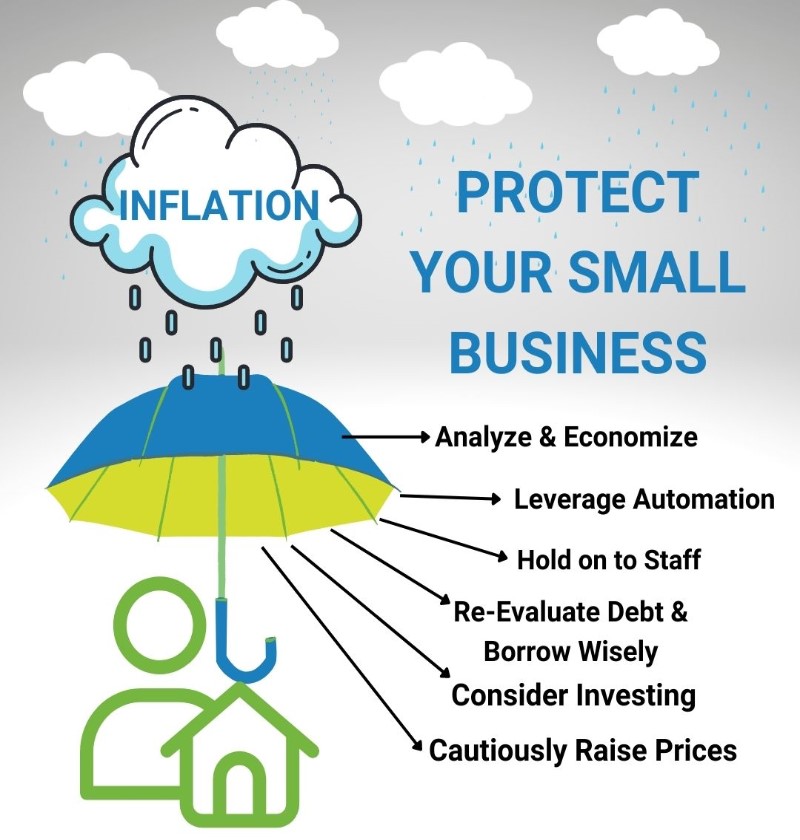Need a few suggestions on how to manage the impact of inflation on your small-business? I think the following might help.
You only have to watch or read the news to realize that inflation is presently of great concern. In fact, closer to home, one only has to purchase groceries or fill up the car at the gas pump to experience its impact on the wallet. Therefore, it should come as no surprise that as an entrepreneur you will be facing challenges.
In order to manage the affects of inflation on your business it is important to have an understanding of what it is, what has caused it, and its possible challenges for your business. Then, you can develop strategies to weaken the repercussions.
What is Inflation?
Simply put inflation is “a measure of each dollar’s dwindling purchasing power” over a period of time. In essence, one needs more money today to buy the same amount of goods as yesterday.
What has Caused Current Inflation?
Generally speaking inflation is usually kept around the 2% mark. This is important because if it’s too low it weakens the economy. However, in May of this year it “hit 8.6% “the highest its been since 1980” when we experienced the oil crisis.
Factors that have contributed to the recent increase of inflation include:
- The pandemic
- The pandemic Government spending surge
- The war in Ukraine
- The rise in consumer demand
- The disruptions to the global supply chain
- The pandemic recovery
For a detailed and insightful explanation of each of the above read the article Solopreneur’s Guide to Inflation.
As a result of these global events, inflation’s blow is felt/experienced by all, including the small- business entrepreneur.
How Does Inflation Impact Small Business?
It doesn’t take a degree in economics to conclude that if the dollar’s purchasing power has decreased your small-business will experience challenges. The type and number of challenges may differ depending upon the type of business you are running.
Inflation will impact Small Business’s to one degree or another in the following 2 ways:
I. Increased Spending
Due to increase costs your business will likely experience an increase in spending in the following areas:
- Overhead and Inventory Costs: Services such as internet, electricity and gas will increase. Materials to produce products will also increase. Forbes writes according “to a Business.org survey, 92%os small-business owners surveyed have dealt with rising costs since the beginning of the pandemic. The supplies and services you need to run your business are ore expensive, and 26% have seen their costs rise by 20%”.
- Wage Increase: If you employ staff you may have to raise their wage/salary in light of the increasing inflation.
- Interest Rates: Should you be considering making a loan, interest rates will have increased therefore, the cost of borrowing increases.
II. Supply Chain Issues
The price of raw materials to manufacture products also increase. Furthermore, the supply of the raw material may have decreased. If the demand for the product remains the same the business is left with finding the best possible source, both in cost and supply. Supply shortages can create a supply chain disruption. Supplies become unreliable and competition increases. Lastly, as gas prices increase, shipping the materials costs more.
The previous items are but two major ways in which small-businesses are challenged. There are numerous articles available for a more detailed description. The article entitled How Inflation Impacts Business is a great resource.
7 Steps to Weaken Inflation’s Impact on Your Business
We are now aware of what inflation is and what has caused the recent inflation crisis, as well as its impact upon small businesses. The question becomes how does a small-business owner manage it? While it is impossible for you do to anything to stop it, the GOOD NEWS is you are not powerless to alleviate its impact upon your small-business.
Step 1: Do a Thorough Audit of your Expenses
Before you do anything else you need to know where you stand. Take time to thoroughly examine where you are spending your money. As you do so be keenly aware of where you can cut costs/where you can consume less.
Step 2: Economize
Once you have a clear idea of where you are at, and where you need to be, begin to economize. There are a variety of ways in which this can be done.
- Evaluate Monthly Subscriptions: If there are some that have not increased productivity, cut them out.
- Buy in Bulk: Stock your shelves with core items that have low holding cost before prices go up.
- Delay an Expenditure: Ask yourself if you can put off a planned expenditure.
- Diversify Your Supply Chain: Ask yourself if substitutions can be made. Try not to rely on one supplier/vendor for your materials. If you have multiple suppliers you can decrease the risk of being stuck and increase your bargaining power.
- Consider Downsizing or Creating a Hybrid Business: Perhaps your business s such that you can consider downsizing your office space and/or having yourself /employees work remotely. Depending on your business and the amount of products you sell you might consider a third party warehouse in order to cut overhead costs.
Step 3: Leverage Automation
Automation can be very useful in managing daily operations. Begin by examining daily practices and ask yourself if there are any areas in the workflow that can be improved upon.
Furthermore, ask yourself what tasks you wish you could off-load. Having done this look for a software solution. The market is full of software that can automate business processes such as scheduling, order taking, billing etc. Bookkeeping software such as Pro-Ledger Online automates some of the tedious tasks.
If there is not a software solution perhaps consider outsourcing to a freelancer or consultant. Their upfront fees and specialized skills may be what you need. In this way you are supplementing your business without the overhead costs needed for a full-time employee.
Step 4: Hold on to your Staff
The labor pool is quite tight at the moment. Recruiting, hiring and training costs money. Therefore, if you have staff it is important that you keep them. Remember, you and your employees are in this together. Even if you are not in a position to give a raise, you can be creative in the way you express your appreciation.
Most employees value flex-time over monetary compensation. Some also prefer telecommuting. Perhaps a bonus at year end would be appreciated. Find out what your employees value and meet them there.
Step 5: Re-Evaluate Your Debt and Borrow Wisely
Debt is no stranger to running a small business. During inflationary times interest rates increase. Therefore, it is critical to examine your debt and adjust accordingly. For example, if you have high-interest credit card debt, transfer it to cards with a lower rate. If you have a loan with a variable interest rate, now is the time to convert to a fixed rate. If you are thinking/planning on borrowing money in the future, it may be a good idea to apply for a small-business loan now and lock in a lower interest rate.
Step 6: Consider Investing
The previous suggestions help you to save money. However another consideration is multiplying your money. If you are in a position to do so it might be worth considering investing. Forbes reminds that the investment you select needs to be outpacing inflation, or at the very least keeping up with it.
Step 7: Carefully Consider Raising Prices
As a small-business owner you may be hesitant to raise your prices. However, given the current circumstances it may be necessary. “According to a CNBCISurveyMonkey survey 40% of small business owners are already raising prices in response to inflation, while another 35% plan to do so if inflation continues.” Before taking this step review your pricing strategy, and consider what you are offering compared to your competition.
Be sure you are offering value. It is wise to raise prices just enough to offset the impact inflation is having and ensuring your business is profitable. “The Philadelphia Inquirer suggest avoiding across-the-board price hikes…raising prices only ‘where customers are most likely to be amiable’ “.
If you do decide to raise prices, be sure to transparent with your customers. Taking care in explaining the increase is critical as you do not wish to alienate them. If you are offering a quality product/service, and given the current circumstances, most of your customers will understand.
While it may be hoped that the inflation rate will come down in the near future, there is no guarantee. Small-businesses need to be prepared as best they can and adjust where they can. It is my hope that the previous 7 tips, when applied, will help your small-business weather the current storm.
____________________________________________________________________________________________________
Pro Ledger Online offers a cloud-based bookkeeping solution for small business professionals. Click here for a 30-day free trial. – www.pro-ledger.com “Bookkeeping Made Simple




